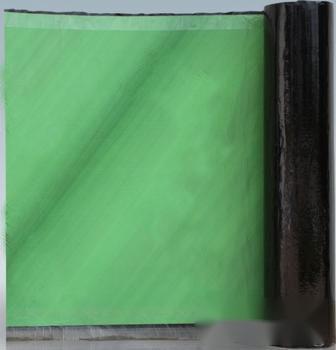1. Product Introduction
PFS reactive adhesive wet-laid waterproof membrane is primarily made of asphalt, incorporating a suitable amount of rubber and additives, manufactured through specific formulation technology and molding processes, resulting in a new type of modified asphalt waterproof membrane. It features a chemical crosslinking reaction and physical interlocking bonding with cast-in-place concrete or cement paste, forming a “skin-like” sealed waterproof layer on the structural surface. The sealing adhesive penetrates the structural capillaries while forming a structural steel-organic frame system during the cement curing process, ensuring that the bonding strength of the membrane to the structure exceeds the strength of the membrane itself (the internal cohesion of the structure is greater than the peeling shear force of the membrane), eliminating the risk of water seepage. This is a new national practical technology product launched by Aoxing Waterproof specifically for concrete sealing and waterproofing.
2. Product Features
1、 High bonding strength;
2、 Excellent dimensional stability, no wrinkling;
3、 Strong impact resistance and puncture resistance;
4、 Excellent nail rod watertightness;
5、 Synergistic effect of chemical crosslinking and physical interlocking;
6、 Irreversible bonding;
7、 Seam bonding can have the same lifespan as the membrane;
8、 Single-layer membrane with double-line waterproofing effect;
9、 Self-healing and self-locking functions;
10、 Binary creep-resistant crack structure with excellent aging resistance;
11、 Low substrate requirements, shortened construction period, and cost savings;
12、 Cold construction, safe and energy-saving environmentally friendly;
13、 High cost-performance ratio;
3. Application Range
PFS reactive adhesive wet-laid waterproof membrane is suitable for waterproofing and seepage prevention in various underground engineering projects, such as basements, civil air defense projects, subway waterproofing projects; waterproofing of roofs and exterior walls of industrial and civil buildings; waterproofing for green planting on underground garage roofs and rooftop gardens; moisture-proofing in humidity-sensitive areas like grain warehouses and electronic workshops; waterproofing and corrosion protection in coastal areas with sea corrosion and significant structural deformation.
4. Packaging, Storage and Transportation
Sealed packaging in special plastic bags, stored in a dry, ventilated environment, protected from sunlight and rain;
Different types and specifications of membranes should be stacked separately, not mixed, and should not be tilted or subjected to crosswise pressure;
When stored flat, the stacking height should not exceed five layers, and it should be single-layer stacked when stored upright;
Storage temperature should not exceed 45℃. During transportation, prevent tilting and lateral pressure, and cover with tarpaulin if necessary.
5. Construction Process
Clean the substrate → Moisten the substrate (this step is not required if the substrate is already wet) → Position and snap lines → Mix and spread cement slurry → Apply the membrane → Lift slurry, vent, and air out → Seal overlapping edges → Seal the membrane ends → Inspect and accept.













